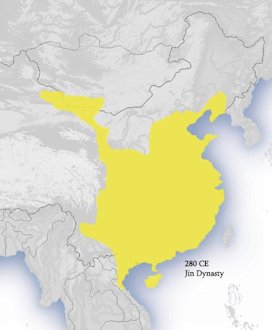
|
Era of Disunity 5. Western Jin Dynasty - 265 to 316 AD - 51 Years
The Jin Dynasty was a dynasty in Chinese history, lasting between the years
265 and 420 AD. There are two main divisions in the history of the Dynasty, the
first being Western Jin and the second Eastern Jin. Western Jin was founded by
Sima Yan, with its capital at Luoyang, while Eastern Jin was begun by Sima Rui,
with its capital at Jiankang. The two periods are also known as Liang Jin by
scholars, to distinguish this dynasty from other dynasties that use the same
Chinese character, such as the Later Jin Dynasty.
In 280, the Jin conquered Eastern Wu and unified China, but internal conflicts, corruption, and political turmoil quickly weakened the dynasty, and the unification lasted only ten years. Upon the advent of the second Jin emperor, Emperor Hui, various imperial princes tried to grab power in the devastating War of the Eight Princes. The Wu Hu uprising followed, during which large numbers of refugees fled south while the north was occupied by various nomadic groups. This marked the end of the Western Jin dynasty in 316 when the Jin court evacuated to the region south of the Huai River, and the beginning of the Eastern Jin and the Sixteen Kingdoms period. Return to 7. Era of Disunity Choices |
| Western Jin Dynasty |